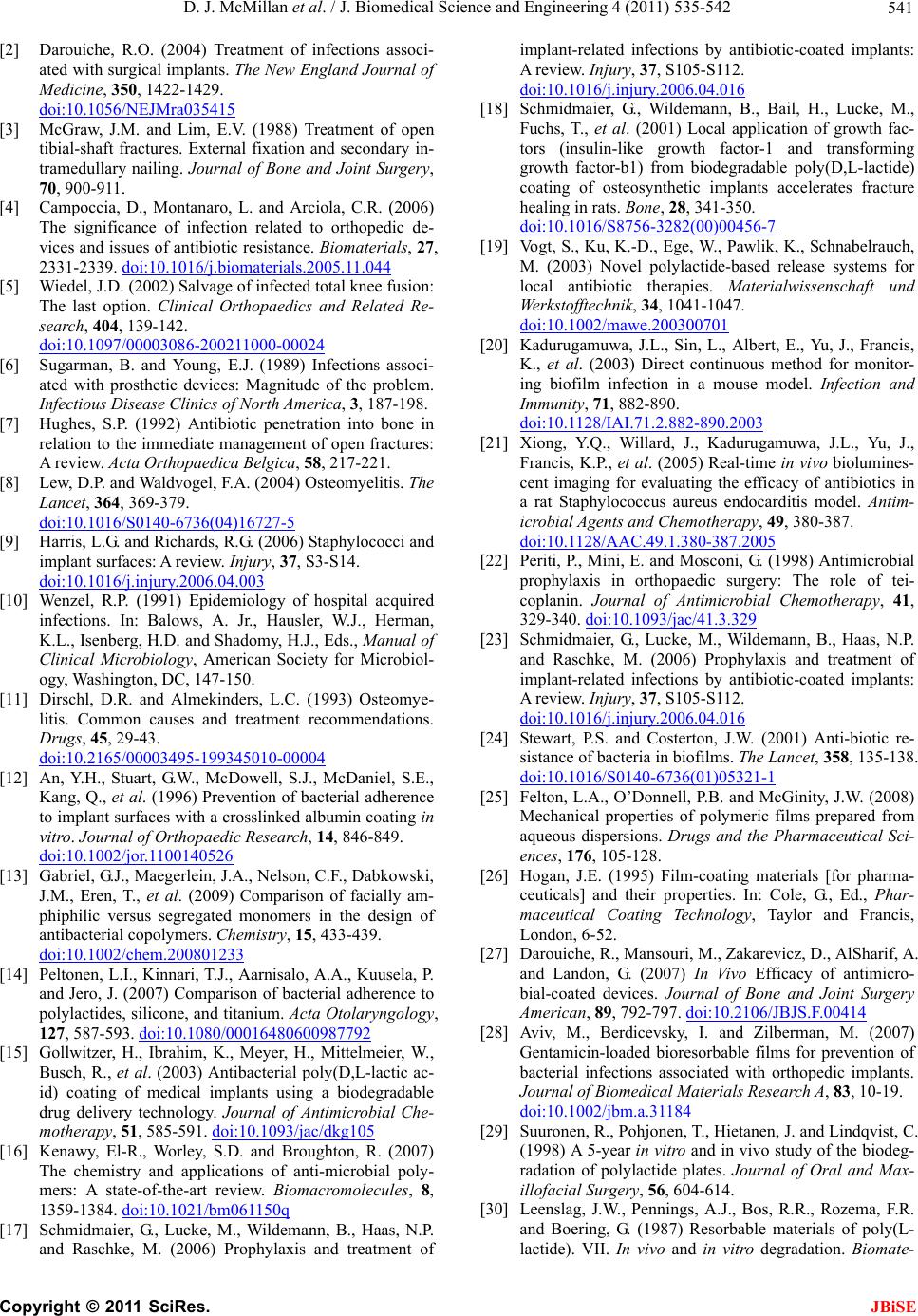
D. J. McMillan et al. / J. Biomedical Science and Engineering 4 (2011) 535-542 541
[2] Darouiche, R.O. (2004) Treatment of infections associ-
ated with surgical implants. The New England Journal of
Medicine, 350, 1422-1429.
doi:10.1056/NEJMra035415
[3] McGraw, J.M. and Lim, E.V. (1988) Treatment of open
tibial-shaft fractures. External fixation and secondary in-
tramedullary nailing. Journal of Bone and Joint Surgery,
70, 900-911.
[4] Campoccia, D., Montanaro, L. and Arciola, C.R. (2006)
The significance of infection related to orthopedic de-
vices and issues of antibiotic resistance. Biomaterials, 27,
2331-2339. doi:10.1016/j.biomaterials.2005.11.044
[5] Wiedel, J.D. (2002) Salvage of infected total knee fusion:
The last option. Clinical Orthopaedics and Related Re-
search, 404, 139-142.
doi:10.1097/00003086-200211000-00024
[6] Sugarman, B. and Young, E.J. (1989) Infections associ-
ated with prosthetic devices: Magnitude of the problem.
Infectious Disease Clinics of North America, 3, 187-198.
[7] Hughes, S.P. (1992) Antibiotic penetration into bone in
relation to the immediate management of open fractures:
A review. Acta Orthopaedica Belgica, 58, 217-221.
[8] Lew, D.P. and Waldvogel, F.A. (2004) Osteomyelitis. The
Lancet, 364, 369-379.
doi:10.1016/S0140-6736(04)16727-5
[9] Harris, L.G. and Richards, R.G. (2006) Staphylococci and
implant surfaces: A review. Injury, 37, S3-S14.
doi:10.1016/j.injury.2006.04.003
[10] Wenzel, R.P. (1991) Epidemiology of hospital acquired
infections. In: Balows, A. Jr., Hausler, W.J., Herman,
K.L., Isenberg, H.D. and Shadomy, H.J., Eds., Manual of
Clinical Microbiology, American Society for Microbiol-
ogy, Washington, DC, 147-150.
[11] Dirschl, D.R. and Almekinders, L.C. (1993) Osteomye-
litis. Common causes and treatment recommendations.
Drugs, 45, 29-43.
doi:10.2165/00003495-199345010-00004
[12] An, Y.H., Stuart, G.W., McDowell, S.J., McDaniel, S.E.,
Kang, Q., et al. (1996) Prevention of bacterial adherence
to implant surfaces with a crosslinked albumin coating in
vitro. Journal of Orthopaedic Research, 14, 846-849.
doi:10.1002/jor.1100140526
[13] Gabriel, G.J., Maegerlein, J.A., Nelson, C.F., Dabkowski,
J.M., Eren, T., et al. (2009) Comparison of facially am-
phiphilic versus segregated monomers in the design of
antibacterial copolymers. Chemistry, 15, 433-439.
doi:10.1002/chem.200801233
[14] Peltonen, L.I., Kinnari, T.J., Aarnisalo, A.A., Kuusela, P.
and Jero, J. (2007) Comparison of bacterial adherence to
polylactides, silicone, and titanium. Acta Otolaryngology,
127, 587-593. doi:10.1080/00016480600987792
[15] Gollwitzer, H., Ibrahim, K., Meyer, H., Mittelmeier, W.,
Busch, R., et al. (2003) Antibacterial poly(D,L-lactic ac-
id) coating of medical implants using a biodegradable
drug delivery technology. Journal of Antimicrobial Che-
motherapy, 51, 585-591. doi:10.1093/jac/dkg105
[16] Kenawy, El-R., Worley, S.D. and Broughton, R. (2007)
The chemistry and applications of anti-microbial poly-
mers: A state-of-the-art review. Biomacromolecules, 8,
1359-1384. doi:10.1021/bm061150q
[17] Schmidmaier, G., Lucke, M., Wildemann, B., Haas, N.P.
and Raschke, M. (2006) Prophylaxis and treatment of
implant-related infections by antibiotic-coated implants:
A review. Injury, 37, S105-S112.
doi:10.1016/j.injury.2006.04.016
[18] Schmidmaier, G., Wildemann, B., Bail, H., Lucke, M.,
Fuchs, T., et al. (2001) Local application of growth fac-
tors (insulin-like growth factor-1 and transforming
growth factor-b1) from biodegradable poly(D,L-lactide)
coating of osteosynthetic implants accelerates fracture
healing in rats. Bone, 28, 341-350.
doi:10.1016/S8756-3282(00)00456-7
[19] Vogt, S., Ku, K.-D., Ege, W., Pawlik, K., Schnabelrauch,
M. (2003) Novel polylactide-based release systems for
local antibiotic therapies. Materialwissenschaft und
Werkstofftechnik, 34, 1041-1047.
doi:10.1002/mawe.200300701
[20] Kadurugamuwa, J.L., Sin, L., Albert, E., Yu, J., Francis,
K., et al. (2003) Direct continuous method for monitor-
ing biofilm infection in a mouse model. Infection and
Immunity, 71, 882-890.
doi:10.1128/IAI.71.2.882-890.2003
[21] Xiong, Y.Q., Willard, J., Kadurugamuwa, J.L., Yu, J.,
Francis, K.P., et al. (2005) Real-time in vivo biolumines-
cent imaging for evaluating the efficacy of antibiotics in
a rat Staphylococcus aureus endocarditis model. Antim-
icrobial Agent s and Chemotherapy, 49, 380-387.
doi:10.1128/AAC.49.1.380-387.2005
[22] Periti, P., Mini, E. and Mosconi, G. (1998) Antimicrobial
prophylaxis in orthopaedic surgery: The role of tei-
coplanin. Journal of Antimicrobial Chemotherapy, 41,
329-340. doi:10.1093/jac/41.3.329
[23] Schmidmaier, G., Lucke, M., Wildemann, B., Haas, N.P.
and Raschke, M. (2006) Prophylaxis and treatment of
implant-related infections by antibiotic-coated implants:
A review. Injury, 37, S105-S112.
doi:10.1016/j.injury.2006.04.016
[24] Stewart, P.S. and Costerton, J.W. (2001) Anti-biotic re-
sistance of bacteria in biofilms. The Lancet, 358, 135-138.
doi:10.1016/S0140-6736(01)05321-1
[25] Felton, L.A., O’Donnell, P.B. and McGinity, J.W. (2008)
Mechanical properties of polymeric films prepared from
aqueous dispersions. Drugs and the Pharmaceutical Sci-
ences, 176, 105-128.
[26] Hogan, J.E. (1995) Film-coating materials [for pharma-
ceuticals] and their properties. In: Cole, G., Ed., Phar-
maceutical Coating Technology, Taylor and Francis,
London, 6-52.
[27] Darouiche, R., Mansouri, M., Zakarevicz, D., AlSharif, A.
and Landon, G. (2007) In Vivo Efficacy of antimicro-
bial-coated devices. Journal of Bone and Joint Surgery
American, 89, 792-797. doi:10.2106/JBJS.F.00414
[28] Aviv, M., Berdicevsky, I. and Zilberman, M. (2007)
Gentamicin-loaded bioresorbable films for prevention of
bacterial infections associated with orthopedic implants.
Journal of Biomedical Materials Research A, 83, 10-19.
doi:10.1002/jbm.a.31184
[29] Suuronen, R., Pohjonen, T., Hietanen, J. and Lindqvist, C.
(1998) A 5-year in vitro and in vivo study of the biodeg-
radation of polylactide plates. Journal of Oral and Max-
illofacial Surgery, 56, 604-614.
[30] Leenslag, J.W., Pennings, A.J., Bos, R.R., Rozema, F.R.
and Boering, G. (1987) Resorbable materials of poly(L-
lactide). VII. In vivo and in vitro degradation. Biomate-
C
opyright © 2011 SciRes. JBiSE